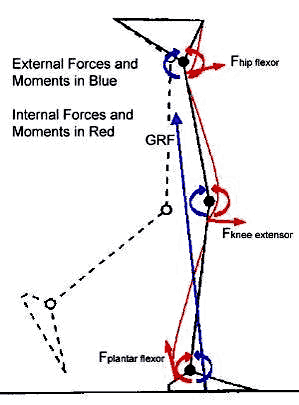Gravity
Without
gravity, powerlifting wouldn't be possible. The
entire concept behind the sport revolves around
exerting a force on a given mass in order to
move it a distance until the point of lock out
which will be explained on each individual lift.
Since powerlifting events take place on Earth
and we know the acceleration of Earths gravity,
the famous formula of Newton's second law can be
used: F=ma.

Ex: Lifter A has
to lift 300 kg in one of the three lifts.
Since a= 9.81
(m/s^2)
F = (300 kg) (9.81m/s^2) = 2940 N
Therefore Lifter
A must exert more than 2940 Newtons
of force to move
the weight upward.
Forces
All forces experienced by the
lifters body are due to gravity. Gravity
applies a downward linear force on the lifter,
and the lifter applies a force in the opposite
direction to prevent the weight from
accelerating to the ground at 9.81 m/s^2. When
the weight is stationary and is not in motion,
the force being applied by the lifter is the
normal force. If the weight is descending, the
applied force is smaller than that of the
gravitational force. If the weight is
ascending, the lifter is supplying a force
greater than that of the force from the
weights. From the perspective of biomechanics,
forces in joints and on different bones vary.
Different stances or grips can make the lift
easier or harder. This is discussed in detail
on each of the individual lifts.
Moments
 Moments also play a
very big role in powerlifting. Moments are created
in joints like the knees, hips, ankles, elbows,
and shoulders. The magnitude of the moment varies
at different stages of the movement. For example,
the moment about the knee is greatest when the
lifters femur is perpendicular to the ground
because the entire vertical load of the weight is
farthest from the knee. Using the equation Moment
= Force x Distance would be used in determining
the magnitude of the force. Since the equation
involves a cross product, a perpendicular load
results in the greatest force. Moments also play a
very big role in powerlifting. Moments are created
in joints like the knees, hips, ankles, elbows,
and shoulders. The magnitude of the moment varies
at different stages of the movement. For example,
the moment about the knee is greatest when the
lifters femur is perpendicular to the ground
because the entire vertical load of the weight is
farthest from the knee. Using the equation Moment
= Force x Distance would be used in determining
the magnitude of the force. Since the equation
involves a cross product, a perpendicular load
results in the greatest force.
f
Work
In addition to forces and moments,
work done on gravity can also be calculated in
all three lifts. In a lift like the dead lift, a
weight is moved from one height to another
meaning that the potential energy of the weight
changes. This change can be calculated using the
equation Work = (Force)(Distance).

Ex: Lifter B performs the dead lift with 200 kg.
he lifts the weight a total height of 0.4
meters.
The potential energy gained can be calculated as
follows:
W = (F)(D)
F = (200 kg)(9.81m/s^2) = 1,962 N
W = (1962
N)(0.4 m) = 784.8 J
|